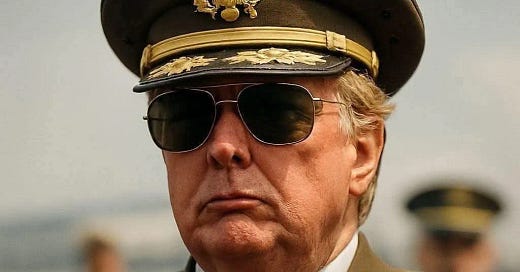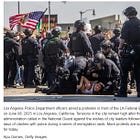Flags, Firepower, and Fear: How Trump Hijacked the Army’s 250th
Confederate Nostalgia, Racial Grievance, and the Politization of the Military
On Tuesday, June 10, 2025, President Donald Trump stood at Fort Bragg to commemorate the 250th anniversary of the U.S. Army.
Officially, the speech was billed as a patriotic tribute. What unfolded on that North Carolina stage wasn’t just a celebration, however. It was something far more revealing.
What we witnessed was a highly choreographed display of loyalty, power, and symbolism. Carefully vetted troops stood behind the president. A crowd cheered as political opponents were booed. Merch booths sold partisan gear. And the speech itself echoed with warnings, not just to foreign enemies, but to fellow Americans.
This wasn’t just about the Army’s past. It was about Trump’s vision for the Army’s future and his own.
We just hit 15,000 subscribers—thank you!
Get exclusive access for just $1/week or $52 a year.
Get exclusive analysis and fearless reporting you won’t find in corporate media.
From Ceremony to Rally
What began as a military commemoration quickly turned into a campaign rally.
Standing beneath American flags at Fort Bragg on June 10, Trump launched into partisan attacks, mocking former President Biden, deriding Governor Gavin Newsom, and encouraging uniformed troops to jeer “fake news.” He even cheered calls to jail protesters and suppress dissent.
Then the speech escalated when he vowed to “liberate” Los Angeles from what he described as a “foreign enemy”, referring to protests sparked by ICE-led mass raids targeting immigrant communities across California. Those protests were already underway, fueled by detentions, family separations, and fear.
By the time Trump spoke, the administration had not only federalized the California National Guard, activating 4,000 troops under Title 10, but also deployed approximately 700 active-duty Marines from the 2nd Battalion, 7th Marines. These forces had arrived on the ground in Los Angeles earlier that same day, marking the first domestic deployment of Marines for civil unrest since 1992.
We have covered the developments in Los Angeles and other cities. See some of our reporting here:
That makes Trump’s comment far more than a rhetorical flourish. It was a direct command, delivered in front of vetted troops, underscoring a chilling readiness to wield the U.S. military on American streets.
This wasn’t about honoring the Army. It was about commanding it publicly, loudly, and with partisan fire.
The Stage Was Rigged
If the crowd behind Trump at Fort Bragg looked unusually uniform, that wasn’t an accident.
Internal directives reveal that the soldiers flanking the president were handpicked, not based on rank, role, or representation, but on optics. Soldiers with dissenting views were quietly removed, and appearance was explicitly prioritized. One leaked memo reveals that there should be “no fat soldiers.”
The result was a backdrop crafted not to reflect the Army, but to reflect Trump’s image of it. While the full demographic makeup of those selected isn’t confirmed, there was no visible effort to reflect the actual diversity of today’s U.S. Army, where over 40% of service members are people of color and roughly 17% are women.
This wasn’t a spontaneous show of support. It was a staged affirmation of loyalty, designed to project control, unity, and alignment—real or not.
MAGA for Sale in Uniform
While Trump spoke at Fort Bragg, vendors set up shop on base property, selling Trump-branded merchandise to uniformed service members during an official military event. That alone skirts long-established Pentagon policy, which prohibits partisan activity on federal installations.
What drew the most shock wasn’t the campaign hats or T-shirts. It was the display of “White Privilege Cards.” These novelty items, printed to mimic fake credit cards, have long circulated in far-right circles as a way to mock racial justice. The card reads: “White Privilege—Trumps Everything.” Multiple service members were seen buying them in uniform.
According to DoD Directive 1344.10, active-duty military personnel may not “participate in partisan political activities” while in uniform, nor may partisan vendors operate on bases in ways that appear to carry military endorsement. Fort Bragg’s leadership has since stated the incident is “under review,” but the damage is done.
This incident unfolded amid a sweeping purge of DEI across the federal government. Trump and Hegseth have dismantled Pentagon diversity offices, canceled cultural heritage months, revoked trans protections, and banned programs they labeled “woke divisive social-justice initiatives.” Selling racially charged merch to troops isn’t just disrespectful. It’s the natural complement to an administration accused of institutionalizing exclusion at the highest levels.
This was more than a technical violation. It was an insult to the military’s core values of unity and cohesion, and to the many Black and Brown service members who watched their fellow troops laugh at a mockery of the systemic challenges they’ve faced in and out of uniform.
What do you do when the person beside you in uniform, the one expected to have your back in combat, buys a card that turns your identity into a punchline?
It wasn’t just tasteless. It was sanctioned disrespect sold at the Army’s own birthday party.
Confederacy by Technicality
One of the most symbolic moves of Trump’s return to power has been his quiet reversal of the 2021 Congressional mandate to strip Confederate names from U.S. military bases.
Under the Biden administration, a bipartisan Naming Commission spent nearly two years researching and recommending new honorees, resulting in base names that reflected modern, inclusive military values. Fort Bragg became Fort Liberty. Fort Hood became Fort Cavazos. Fort Lee became Fort Gregg-Adams.
But earlier this year, in February, Trump’s Secretary of Defense, Pete Hegseth, issued a series of directives that effectively reversed those changes, without openly defying the law. How? By renaming the bases after different historical figures who happened to share the same last names.
Fort Liberty was renamed “Fort Bragg” again, but this time for Union medic Pfc. Roland Bragg, not Rebel General Braxton Bragg. Fort Hood now honors World War I chaplain Col. Robert B. Hood, not Confederate General John Bell Hood. Other reversions followed the same pattern—same name, different story—performed with no public ceremony or context.
Retired Brig. Gen. Ty Seidule, vice chair of the Naming Commission and a veteran critic of Confederate glorification, condemned the move: “This violates the spirit of post‑George Floyd legislation … it’s a deliberate subversion of the whole purpose of removing Confederate names.”
This legal sleight of hand undermines the intent of a bipartisan law aimed at removing symbols that glorify slavery and insurrection. It’s a wink and a nod to white grievance politics.
It’s not honoring diverse heroes but restoring ghosts.
Tanks, Flyovers, and a Chilling Signal
On Saturday, June 14, the streets of Washington, D.C. will be lined with tanks, armored vehicles, and marching troops to mark the 250th anniversary of the U.S. Army. It also happens to be Flag Day and Donald Trump’s birthday.
Just four days earlier, Trump used his speech at Fort Bragg to test the optics: handpicked troops cheering him on, attacks against political opponents, and threats to use military force on protestors. That wasn’t just a celebration. It was a dress rehearsal.
While military parades are extremely rare in the United States, reserved primarily for postwar celebrations, Trump has long fantasized about bringing “his generals” into the streets. He had previously proposed a parade during his first term but was rejected by the military and fiscal conservatives due to concerns over optics and cost.
This weekend, that vision becomes reality.
The stakes are higher today than then, and more than just optics. In his Fort Bragg speech, Trump issued a stark warning: any protestors who show up to the parade “will be dealt with harshly” and met with “very big force.” The threat was delivered without qualification, with no distinction between peaceful demonstrators and violent agitators.
This comes amid ongoing ICE raids and protests in cities like Los Angeles, where active-duty Marines have already been deployed domestically for the first time in decades.
In this context, a military parade doesn’t read as a celebration so much as a warning.
When a president threatens protestors and floods the capital with tanks on his birthday, it stops being pageantry and starts being propaganda.
See our recent reporting on the parade (and hunt for attendees) here:
Cutting Services, Funding Spectacle
While tanks roll through Washington, D.C., the Senate is preparing to vote on a Trump-backed budget that would gut essential services for millions of Americans.
The plan calls for $864 billion in Medicaid cuts over ten years, with $344 billion of that stemming from new work requirements. SNAP, the nation’s food stamp program, would be reduced by another $267 billion. Housing subsidies, student aid, veterans’ healthcare, and climate programs are all on the chopping block.
See our OBBB reporting here:
And yet, there’s money for this.
There’s money to send Marines and National Guard troops into American cities to suppress protests. There’s money to stage a military parade in the heart of the capital, coinciding not just with the Army’s 250th birthday, but with the president’s own. Estimates peg the cost of the parade at $25 to $45 million, excluding the $16 million that D.C. will spend to repair roads damaged by tanks and armored vehicles.
It’s the clearest expression yet of this administration’s priorities: cut food, cut housing, cut health, but never cut spectacle.
This isn’t austerity. It’s authoritarianism, funded by the people it leaves behind.
March Where It Matters Most
In response to the parade, a wave of protests has been organized under the banner No Kings, a decentralized, national movement focused on resisting authoritarianism through peaceful defiance. Events are planned in more than 1,500 cities and towns nationwide.
That’s where the focus should stay.
Trump has explicitly threatened protesters, warning they will be met with “very big force.” In a militarized zone filled with active-duty troops, federal agents, and surveillance infrastructure, even peaceful protest could carry outsized risk.
Flooding his parade with opposition only strengthens his narrative. He wants confrontation. He wants the optics of conflict. What he doesn’t want is the embarrassment of empty seats and a silent crowd.
By attending a No Kings event near you, you can stand in solidarity with thousands, safely, visibly, and in greater numbers than he can ever match in D.C.
He has the tanks. We have the people. Choose power over provocation.
This Isn’t Patriotism. It’s Propaganda.
A president stood on a military base and called for loyalty, not unity. He booed his political opponents, mocked the free press, and threatened force against peaceful protest. He did it with soldiers at his back—curated, silent, and in uniform.
He sold merchandise mocking the very people who serve beside them. He reversed names meant to honor progress and slipped old ghosts back into new uniforms. And now, he’s preparing to parade tanks through the capital on his birthday, daring anyone to speak up.
This isn’t tradition. It’s theater.
This isn’t strength. It’s spectacle.
And this isn’t patriotism. It’s propaganda.
The choice isn’t whether we watch; it’s whether we accept it.
Show up for democracy, not for the parade.
Call to Action
Find a No Kings protest near you: nokings.org/#map
Call the Congressional Switchboard at (202) 224‑3121 to reach your U.S. Senator or Representative.
Sample script:
“Hi, my name is [Your Name], and I’m a constituent from [Your City]. I’m calling to demand that [Senator/Representative’s Name] speak out against the politicization of the military and the use of federal resources for President Trump’s parade and partisan events. I also urge [him/her/them] to support legislation to prevent the abuse of military power for domestic political theater. Thank you.”
Share this piece: Help others see what’s happening and what’s at stake.
We just hit 15,000 subscribers—thank you!
Get exclusive access for just $1/week or $52 a year.
Get exclusive analysis and fearless reporting you won’t find in corporate media.
Bibliography:
“Assault on Peace”: Trump Calls Los Angeles Protests ‘Assault on Peace’ in Speech to Soldiers at Fort Bragg.” CBS News, June 10, 2025.
“Trump Calls Los Angeles Protestors ‘Animals’ in a Speech at Fort Bragg.” AP News, June 10, 2025.
Bertrand, Natasha, Haley Britzky, and Zachary Cohen. “Army Expects to Spend Up to $45 M for Its 250th Birthday Celebration in DC.” NPR, June 12, 2025.
Currie, James T. “I Served in the Marines. Sending Them to Los Angeles Is Wrong.” The Washington Post, June 12, 2025.
“Tax Bill Would Slash $1 Trillion From Medicaid, Health Care System: CBO.” KFF, June 5, 2025.
“Official House Bill Analysis Confirms Devastating Coverage Losses.” Medicare Watch, June 5, 2025.
“How Much Will the DC Military Parade Cost? Here’s a Tally.” NBC4 Washington, June 10, 2025.
“Trump’s Pentagon Parade Will Cost Lives and Livelihoods.” Newsweek, June 12, 2025.
“Marines to Deploy on LA Streets within Two Days with Authority to Detain Civilians.” Reuters, June 11, 2025.
“5 Things $45 Million Could Pay For Instead of a Massive Military Parade.” SPLC, June 6, 2025.
Ty Seidule quoted in “Trump's Strongman Week: Inside his Show of Military Force.” Axios, June 11, 2025.
U.S. Department of Defense. Department of Defense Directive 1344.10, “Political Activities by Members of the Armed Forces,” February 19, 2008.
“Trump, at Fort Bragg, Vows to Use Force Against ‘Anarchy.’” The Washington Post, June 10, 2025.












Thos was absolutely despicable!!